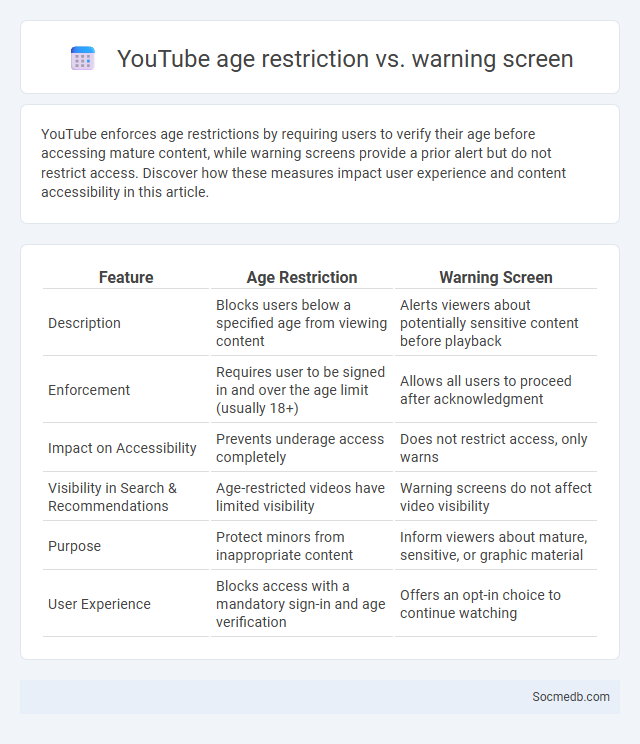
Photo illustration: YouTube age restriction vs warning screen
YouTube enforces age restrictions by requiring users to verify their age before accessing mature content, while warning screens provide a prior alert but do not restrict access. Discover how these measures impact user experience and content accessibility in this article.
Table of Comparison
| Feature | Age Restriction | Warning Screen |
|---|---|---|
| Description | Blocks users below a specified age from viewing content | Alerts viewers about potentially sensitive content before playback |
| Enforcement | Requires user to be signed in and over the age limit (usually 18+) | Allows all users to proceed after acknowledgment |
| Impact on Accessibility | Prevents underage access completely | Does not restrict access, only warns |
| Visibility in Search & Recommendations | Age-restricted videos have limited visibility | Warning screens do not affect video visibility |
| Purpose | Protect minors from inappropriate content | Inform viewers about mature, sensitive, or graphic material |
| User Experience | Blocks access with a mandatory sign-in and age verification | Offers an opt-in choice to continue watching |
Understanding YouTube’s Content Regulation Policies
YouTube's content regulation policies prioritize community guidelines to maintain a safe platform by restricting harmful or inappropriate content such as hate speech, misinformation, and violent material. The platform employs automated algorithms alongside human reviewers to enforce rules and remove content that violates standards. Understanding these policies is crucial for creators seeking to avoid strikes and ensure their videos comply with evolving legal and ethical norms.
What is YouTube Age Restriction?
YouTube age restriction limits access to specific videos for users under 18 to protect younger audiences from inappropriate content. This setting is enforced through account age verification and content rating systems, ensuring compliance with community guidelines and legal requirements. Your experience is safeguarded by preventing exposure to mature or sensitive material unless you confirm your age.
How the Warning Screen Functions on YouTube
The Warning Screen on YouTube appears before videos flagged for potentially sensitive or inappropriate content, alerting viewers about the nature of the material. This screen functions to provide users with an informed choice, often requiring them to acknowledge the warning before proceeding to watch the video. By filtering content through algorithmic detection and user reports, YouTube enforces community guidelines while balancing freedom of expression and user safety.
Age Restriction vs Warning Screen: Key Differences
Age restriction on social media platforms legally prevents users below a specified age, often 13, from accessing content, ensuring compliance with regulations like COPPA. Warning screens serve as disclaimers, alerting users about potentially sensitive or explicit content without barring access, allowing informed user discretion. These mechanisms balance user safety and freedom, with age restrictions enforcing mandatory limits, while warning screens offer cautionary advice.
Criteria for Triggering YouTube Age Restrictions
YouTube age restrictions activate based on content that includes violence, sexual themes, or harmful behavior unsuitable for viewers under 18, adhering to community guidelines and legal standards. Videos containing explicit language, mature themes, or drug use also trigger age gating to protect younger audiences. The platform uses automated systems combined with human review to evaluate and enforce these criteria consistently.
When Does YouTube Use a Warning Screen?
YouTube uses a warning screen when content potentially violates its community guidelines or is age-restricted to protect viewers from sensitive material. This screen appears before videos containing violence, nudity, or harmful behavior, requiring users to confirm their age or acknowledge the content. Your experience remains safer as these warnings help prevent unintended exposure to inappropriate or harmful content.
Effects of Age Restriction on Video Visibility and Monetization
Age restrictions on social media platforms significantly impact video visibility by limiting content reach to specific age groups, which reduces overall engagement and viewership metrics. This constraint often results in lower monetization potential, as advertisers prefer videos with broader audience access to maximize ROI. Understanding your demographic targeting and age-related content policies empowers you to optimize your video strategy for both visibility and revenue generation.
User Experience: Age-Restricted Content vs Warning Screen Content
User experience on social media platforms is significantly impacted by how age-restricted content is managed, with direct age restrictions often providing clearer access control compared to warning screens that rely on user discretion, which can lead to inconsistent exposure. Studies show that platforms enforcing strict age verification reduce underage access to sensitive material more effectively, enhancing parental control and legal compliance. Optimizing user experience involves balancing content safety measures with seamless navigation, ensuring users are neither overwhelmed by warnings nor exposed to inappropriate content.
Creator Guidelines: Avoiding Age Restrictions and Warnings
Adhering to social media creator guidelines is essential for avoiding age restrictions and warnings that can limit your content's reach and engagement. You should carefully review platform-specific rules regarding explicit language, sensitive themes, and age-appropriate material to ensure compliance. Consistently applying these guidelines protects your account's visibility and fosters a positive experience for your audience.
The Impact of Content Restriction on YouTube’s Ecosystem
Content restriction on YouTube significantly shapes the platform's ecosystem by influencing creator behavior and audience engagement patterns. YouTube's algorithms and community guidelines tighten controls to moderate content, affecting which videos get monetized or promoted, thus impacting creators' revenue streams and visibility. Your ability to discover diverse content may be limited as the platform prioritizes brand-safe and advertiser-friendly videos, altering the breadth and depth of information accessible on the site.
 socmedb.com
socmedb.com